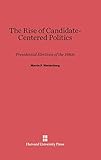The Rise of Candidate-Centered Politics : Presidential Elections of the 1980s / Martin P. Wattenberg.
Material type: TextPublisher: Cambridge, MA : Harvard University Press, [2013]Copyright date: ©1991Edition: Reprint 2014Description: 1 online resource (186 p.) : illustrationsContent type:
TextPublisher: Cambridge, MA : Harvard University Press, [2013]Copyright date: ©1991Edition: Reprint 2014Description: 1 online resource (186 p.) : illustrationsContent type: - 9780674865709
- 9780674865723
- 324.973/092
- JK2261
- online - DeGruyter
| Item type | Current library | Call number | URL | Status | Notes | Barcode | |
|---|---|---|---|---|---|---|---|
 eBook
eBook
|
Biblioteca "Angelicum" Pont. Univ. S.Tommaso d'Aquino Nuvola online | online - DeGruyter (Browse shelf(Opens below)) | Online access | Not for loan (Accesso limitato) | Accesso per gli utenti autorizzati / Access for authorized users | (dgr)9780674865723 |
Frontmatter -- Preface -- Contents -- Tables -- Figures -- Introduction -- One. Theories of Voting -- TWO. Dealignment in the Electorate -- THREE. The Era of Party Disunity -- FOUR. Presidential Popularity in Decline -- FIVE. Was There a Mandate? -- SIX. Performance-Based Voting -- SEVEN. The Impact of Candidate-Centered Politics -- Notes -- Index
restricted access online access with authorization star
http://purl.org/coar/access_right/c_16ec
Every presidential election since 1964 has been won by the candidate backed by the most united party; yet as party unity has become more important to voting decisions, it has also become increasingly difficult to achieve. In his latest book, Martin Wattenberg offers an in-depth interpretation of the presidential elections of the 1980s, illuminating current theories of political behavior and how they operate in today's candidate-centered politics. Wattenberg investigates the impact that political parties' declining relevance has had on presidential politics. As the parties' ability to polarize opinion weakened and voters were set politically adrift, the candidates themselves had to fill the power vacuum. Interestingly, as the candidates have become more prominent, their popularity has spiraled downward. Wattenberg's national survey data debunks the notion of Reagan as the "teflon president;' demonstrating that many negative judgments stuck to Reagan's public image throughout the 1980s, particularly the criticisms of his conservative policies. The author's intricate analysis shows that many people were torn between candidates whose policies they preferred and those who they thought would produce the best results, and these contradictory attitudes were primarily resolved in favor of Reagan and Bush. This book is not only the successor volume to the author's widely used book on American parties, it is also a controversial and thought-provoking commentary on American parties, politics, and representative government.
Mode of access: Internet via World Wide Web.
In English.
Description based on online resource; title from PDF title page (publisher's Web site, viewed 24. Aug 2021)


